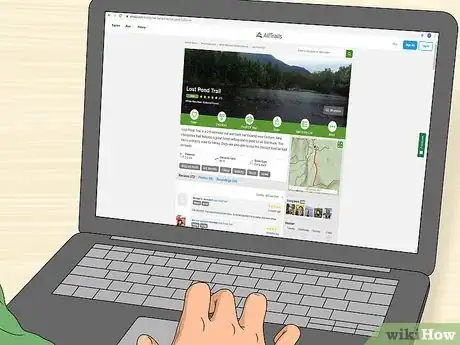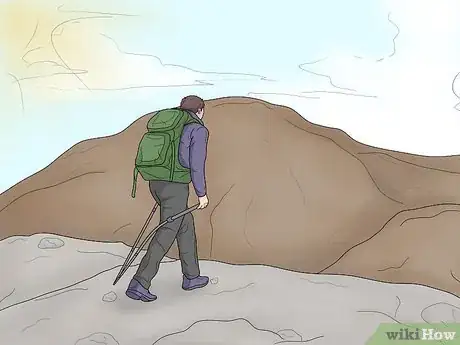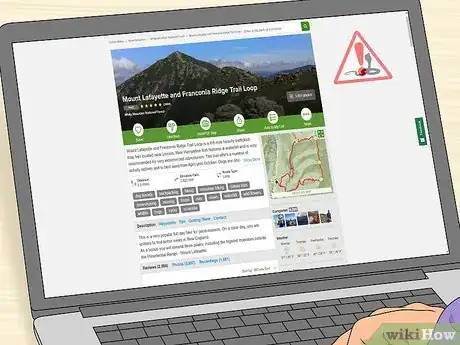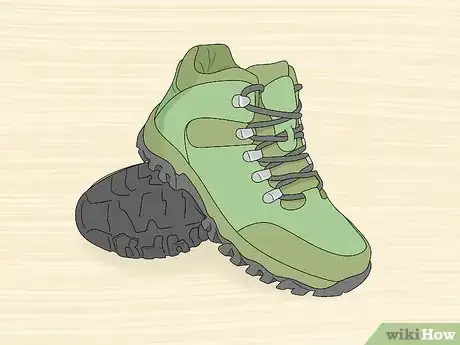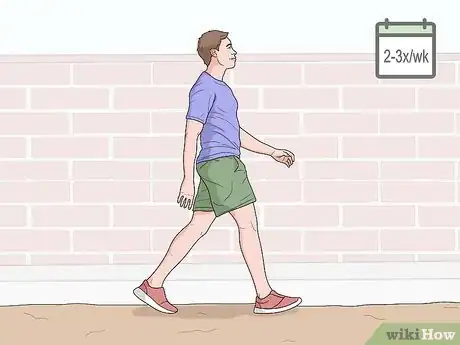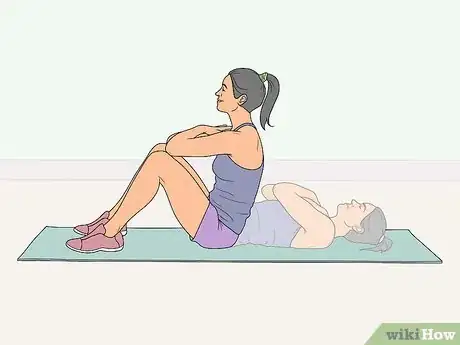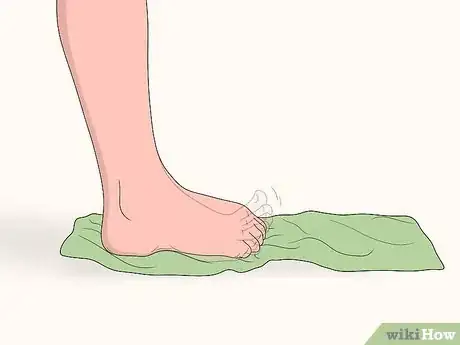This article was co-authored by Katie Prendergast and by wikiHow staff writer, Hunter Rising. Katie Prendergast is a Certified Personal Trainer, Nutrition Coach, and the Owner of KPxFitness. With over seven years of coaching experience, she has expertise in helping skiers, snowboarders, and hikers build strength and endurance to enjoy more outdoor adventures. Katie earned her Personal Training Certification and Corrective Exercise Specialist Certification from The National Academy of Sports Medicine (NASM) and is a Pain-Free Performance Specialist (PPSC).
There are 18 references cited in this article, which can be found at the bottom of the page.
wikiHow marks an article as reader-approved once it receives enough positive feedback. In this case, 100% of readers who voted found the article helpful, earning it our reader-approved status.
This article has been viewed 152,522 times.
Hiking is a great way to spend time outdoors and get a lot of exercise. While you may be eager to go out into the wilderness, taking time to prepare for your hike will help keep you safe and comfortable. Even if you’re just going out for a day hike, there are essentials you should bring with you. If you plan on going on a more advanced hike, warm up with some exercise beforehand so you don’t get exhausted later on. As long as you plan ahead, you'll be ready to take on any hike!
Steps
Planning Your Hike
-
1Choose a trail that’s within your skill level. If you’re a beginner and you haven’t had a lot of experience hiking, pick shorter trails that have gentle inclines so you don’t get as tired. If you have more experience hiking, you can also try wilderness trails that are steeper or have more difficult footing. Only choose long, steep trails if you’ve been hiking a lot since they can be dangerous to attempt them if you aren’t prepared for the conditions.[1]
-
2Check the route and trail conditions online if you can. Search the park’s website for a trail map or use a hiking website, like AllTrails or Hiking Project, to find trails near you. Pay attention to how long the trail is and how long it normally takes to complete the round-trip. A few days before and on the morning of your hike, check the conditions to see if they’ve changed and affected the route. Make note of the trail condition so you can wear shoes that offer the most support.[2]
- Trails do close from time to time, so always be sure to check if they’re open before you leave for your hike.
- Many other hikers rate and describe the trails they use, so read through them to see if the trail is right for you.
- Keep track of the amount of time you’ve been hiking and leave the same amount of time before sunset so you can get back to your starting point before dark.
Advertisement -
3Look up the weather forecast so you can plan your outfit. Check the hourly forecast to see how warm it’s going to be during your hike. If it’s going to be cold, you’ll have to pack more layers so you stay warm. Also be sure to check if it’s going to rain, since you may want to bring a rain jacket or waterproof clothes so you stay dry.[3]
- The temperature can drop quickly if you change altitudes during your hike, so bring extra layers of clothes in case you get cold.
-
4Choose to hike in the morning or afternoon while the sun is out. Trails are usually less busy in the morning and temperatures are cooler so you’ll feel more comfortable. Otherwise, pick a time in the afternoon while the sun is still out. Avoid hiking after dark if you can since you may not notice uneven trails and could get lost.[4]
- Your pace may vary depending on the difficulty of the trail.
Tip: Typically, your hike will take 30 minutes per 1 mile (1.6 km) and an additional 30 minutes for every 1,000 feet (0.30 km) of uphill elevation. So a flat 4 mi (6.4 km) loop would take about 2 hours to complete.
-
5Learn about what dangerous animals may live in the area. Hiking in the wilderness is great for getting closer to nature, but there may be some animals to avoid. Search on the park or trail’s website to find out what animals have been spotted in the area and what you should do if you encounter one.[5]
- For example, there could be bears, wolves, or mountain lions in your area.
- Most animals are as scared of you as you are scared of them. Usually, animals will avoid you as long as you avoid them.
-
6Ask someone to hike with you so you stay safe. Avoid hiking alone since you won’t be able to reach someone in case there’s an emergency. Talk to other friends that hike and see if they want to come with you. Otherwise, you may be able to find hiking groups in your area. Try using an app like Meetup or checking for flyers at an outdoor supply store.[6]
- Ask the person what distance they’re comfortable hiking. You may need to adjust your route if they aren’t as experienced.
-
7Tell other people where you’re hiking and how long you’ll be gone. Before you leave, talk to other friends and family members and let them know exactly where you’re going. Show them a map of the trail and mention what time you plan to be finished. That way, someone knows where you are in case there’s an emergency.[7]
- While you’re out on the hike, try to check in on a set schedule so your friends and family know you’re safe.
Dressing and Packing
-
1Wear breathable layers of clothing. Even if you’re hiking in the heat of summer, bring multiple layers of thin, breathable clothes just in case it gets colder. Pack a long-sleeved shirt and a pair of pants so that you can put them on over your other clothes. Choose fabrics that are labeled “moisture-wicking” to help you stay cool and dry throughout the hike.[8]
- Avoid cotton clothing since it holds moisture and can get heavy.
- Opt for lighter colors since you’ll feel cooler and you’ll be able to spot any ticks or pests easier.
-
2Put on trail shoes or hiking boots for the best foot support. If you’re only going on a light hike on an easy trail, you can probably get away with wearing a comfortable pair of tennis shoes. Otherwise, look for trail shoes or hiking boots that are stiff so you don’t sprain or twist your ankle. Make sure your shoes or boots fit tightly and are comfortable since you’ll be walking in them for a few hours.[9]
- If you’re breaking in new shoes or boots, wear them out for hikes that are 1–2 miles (1.6–3.2 km) to break them in. As they get more comfortable, increase your distance.
-
3Carry your cell phone with you at all times. Make sure your cell phone is in a convenient location where you won’t lose it. Put it in your pocket, an arm band, or a backpack so it can’t fall out. Use your phone to take pictures, track your location, watch the time, and to make phone calls if there’s an emergency.[10]
- Check in with other friends and family throughout your hike so they know you’re safe.
- Consider bringing a portable charger for your phone just in case the battery dies while you’re on the trail.
- You may not get service depending on where you’re hiking.
-
4Use a backpack with chest or waist straps. Choose a lightweight backpack so you don’t have a lot of weight to carry.[11] Try to find something that fits well on your back and has comfortable padding on the straps. Check if there are straps that go around your chest and waist so you don’t have so much weight on your shoulders throughout the hike.[12]
- Hiking backpacks are more lightweight and have more convenient storage than regular backpacks. You can buy one from an outdoor supply store, but they usually will cost around $50–200 USD.
- Avoid stuffing your backpack full since it will get really heavy and will be difficult to carry.
-
5Take a map and compass in case you get lost. Even if you have a GPS on your phone, you may need to use a map in an emergency. Try to find a topographical map of the area so you can easily locate landmarks and trails. Make sure you have a compass so you can determine which direction you’re facing.[13]
- You can usually get a trail map at a park ranger’s stations or a visitor center.
- As a quick reference, remember that the sun rises in the east and sets in the west. If you find the sun in the sky, you can get a rough idea of which direction you’re facing.
-
6Bring nutritious snacks with carbs and proteins to help you stay energized. Avoid fatty or sugary snacks since they won’t provide as many nutrients. Instead, look for snacks that have lots of carbs or proteins, such as beef jerky, nuts, trail mix, or granola bars. You can also eat fruit and vegetables if you want something fresh. Always pack enough food so you have enough for an extra day just in case there’s an emergency.[14]
- Other foods you can bring include dried fruit, seeds, tuna or salmon pouches, and cheese.[15]
- Keep any food packaging in your backpack so you can throw it away properly later.
-
7Pack 1 US pt (0.47 L) of water for every hour you’ll be gone. Look for insulated water bottles so it stays cold while you’re hiking. Look at how much time it takes to hike the trail and have at least 1 US pint (0.47 L) per hour. Keep the water bottles in an easy-to-reach spot in the side or top pockets of your backpack.[16]
- You may need more water if there are high temperatures or if you’re hiking a more strenuous trail.
Tip: If you can’t pack or carry enough water, bring a way to purify water with you. You can either boil it, mix it with iodine tablets, or run it through a filter.[17]
-
8Apply bug spray and sunscreen every 2 hours while hiking. Look for bug spray that has DEET since it helps repel mosquitoes, flies, and ticks more efficiently. If the sun is out, get sunscreen that’s at least 30 SPF and rub it into any exposed skin. Reapply the bug spray and sunscreen about every 2 hours since the other applications will sweat off.[18]
- You can also wear a hat and sunglasses to keep the sun out of your eyes.
- Check your legs and pants for ticks if you walk through tall grass.
-
9Keep an emergency kit in your pack in case of an accident. Include bandages and disinfectant so you can help with minor scrapes and cuts. Also pack a signal mirror, a piece of bright-colored cloth, and a whistle to make it easier to get someone else’s attention from a distance. Carry a headlamp with you just in case it gets dark so you can see the trail and are more visible to other people. Put matches and a pocket knife or multi-tool in the kit as well so you can start a fire and make repairs to your gear if you need to.[19]
- If you’re planning a multi-day trip, plan on bringing a tent or emergency shelter as well.
-
10Use trekking poles to help brace your knees. Trekking poles are sturdy walking sticks that take pressure off your knees so you don’t feel as sore at the end of your hike. Adjust the height of your trekking poles so they reach the ground when you have your elbows bent at 90 degrees. Make sure the poles have a comfortable grip, or else your hands will get sore as you use them.[20]
- You can buy trekking poles from your local outdoor supply store.
- You do not need trekking poles for your hike if you don’t want them.
Conditioning for Advanced Hikes
-
1Eat a meal with carbs and protein before your hike. Carbs and protein help give your body energy so you don’t get exhausted while you’re out on your hike. Opt for something like oatmeal, eggs, pasta, and lean meat since they’re nutritious. Incorporate fruits and vegetables into your meal as well for additional carbs and natural sugars.[21]
- Avoid overeating since you may feel uncomfortable while you’re out hiking.
-
2Go for long walks 2–3 times a week.[22] Walk at a comfortable pace where you can still hold a conversation without breathing heavily. Start with walks that are about 30–60 minutes long so you don’t get too worn out. Take a rest day between walks so you don’t get any sprains. At least once a week, go on a walk that’s 2 hours or longer so you can build your stamina. By the time you go on your hike, you should be comfortable going on walks that last 4–6 hours.[23]
- Try walking on different terrains since hiking trails aren’t usually paved.
- Track how far you walk using your phone or smartwatch so you know your pace.
- Take the stairs whenever you can so you get used to climbing elevation. If you have gym access, incline treadmill walking is a great way to condition for hiking.[24]
Tip: Make sure your heel strikes the ground first when you step down to prevent shin splints and pulled tendons.
-
3Incorporate squats and lunges into your workout to strengthen your legs.[25] Keep your back straight and feet shoulder-width apart. To do a squat, bend your knees until they’re at a 90-degree angle. Hold the position for a count before standing up again. If you want to do a lunge, step forward with 1 leg and bend your knees at 90-degree angles. Push yourself back up to a standing position. Do 2–3 sets that are 10 reps each.[26]
- Working out your legs prevents them from getting sore and exhausted while you’re in the middle of your hike.
- Hold dumbbells while performing squats or lunges if you want to build more muscle.
-
4Exercise your core to improve your balance. You’ll have to carry hiking gear and supplies, so it may be difficult to keep your balance on uneven trails. Try doing 10–20 sit-ups or holding a plank position for 30 seconds to help you build up your core. Aim to do 2–3 sets of each exercise at least 2–3 times per week.[27]
-
5Try foot exercises to prevent sprains and aches. Spread a towel flat on the floor and set your foot on top of it. Keep your heel still and grab the towel with your toes. Pull the towel closer toward your heel before stretching your foot out again. Do this 5 times with each foot. You can also pick up marbles with your toes and drop them into a cup as an alternative way to stretch your arches.[28]
- If your feet get sore, lay a cold bottle horizontal on the floor and roll your foot over it.
-
6Practice cardio exercises to help increase your stamina.[29] Even though going for a walk is a cardio exercise, try doing something that’s more high-intensity a few times a week. Focus on cardio exercises that work your legs, such as running, cycling, soccer, or swimming. Work on your cardio at least 2–3 times a week on top of your walks.[30]
- Include high-intensity cardio in your walks. For example, you could jog for 10–20 minutes in the middle of your walk to raise your heart rate.
Expert Q&A
Did you know you can get premium answers for this article?
Unlock premium answers by supporting wikiHow
-
QuestionHow do beginners prepare for hiking?
 Katie PrendergastKatie Prendergast is a Certified Personal Trainer, Nutrition Coach, and the Owner of KPxFitness. With over seven years of coaching experience, she has expertise in helping skiers, snowboarders, and hikers build strength and endurance to enjoy more outdoor adventures. Katie earned her Personal Training Certification and Corrective Exercise Specialist Certification from The National Academy of Sports Medicine (NASM) and is a Pain-Free Performance Specialist (PPSC).
Katie PrendergastKatie Prendergast is a Certified Personal Trainer, Nutrition Coach, and the Owner of KPxFitness. With over seven years of coaching experience, she has expertise in helping skiers, snowboarders, and hikers build strength and endurance to enjoy more outdoor adventures. Katie earned her Personal Training Certification and Corrective Exercise Specialist Certification from The National Academy of Sports Medicine (NASM) and is a Pain-Free Performance Specialist (PPSC).
Certified Personal Trainer & Nutrition Coach Beginners can train for hiking by focusing on their baseline aerobic fitness. You can do this by spending a lot of time in heart rate zone 2, which is considered "light" cardio. If you have a heart rate monitor, you'll want to exercise at 60-70% of your maximum heart rate. Plan for 2-3 weekly cardio training sessions in zone 2, slowly adding time each week as you go.
Beginners can train for hiking by focusing on their baseline aerobic fitness. You can do this by spending a lot of time in heart rate zone 2, which is considered "light" cardio. If you have a heart rate monitor, you'll want to exercise at 60-70% of your maximum heart rate. Plan for 2-3 weekly cardio training sessions in zone 2, slowly adding time each week as you go. -
QuestionIs it safe for a thirteen year old to do a five hour hike?
 AlissaBCommunity AnswerDefinitely, if you're well prepared and pace yourself. If you have done shorter hikes and stay generally active, your body can handle the distance. The most important part is to be prepared, know the route, and stay safe. Hopefully you're hiking with an adult who knows the route and can make sure you don't get lost (hiking alone in remote areas is risky, even for adults). Use this article to prepare for the weather and distance by bringing the right kinds of clothing, gear, and enough food and water. Learn about any likely difficulties on the trail (animals, weather, route finding) and make sure you have a plan for dealing with them. Then, go enjoy your hike!
AlissaBCommunity AnswerDefinitely, if you're well prepared and pace yourself. If you have done shorter hikes and stay generally active, your body can handle the distance. The most important part is to be prepared, know the route, and stay safe. Hopefully you're hiking with an adult who knows the route and can make sure you don't get lost (hiking alone in remote areas is risky, even for adults). Use this article to prepare for the weather and distance by bringing the right kinds of clothing, gear, and enough food and water. Learn about any likely difficulties on the trail (animals, weather, route finding) and make sure you have a plan for dealing with them. Then, go enjoy your hike! -
QuestionIs it safe for a seven and seventeen year old to hike for three days?
 Community AnswerIf the climatic conditions are good, it should be safe. If not, it could be dangerous.
Community AnswerIf the climatic conditions are good, it should be safe. If not, it could be dangerous.
Warnings
- Avoid overpacking since you’ll have more weight to carry and you could get exhausted.⧼thumbs_response⧽
- The temperature can change quickly while you’re hiking, so take a few extra layers of clothing just in case.⧼thumbs_response⧽
- Always tell someone where you’re hiking and how long you expect to be gone if you go hiking alone. Check in with them frequently so they know you’re safe.⧼thumbs_response⧽
Things You’ll Need
- Breathable clothes
- Trail shoes or hiking boots
- Backpack
- Cell phone
- Water bottles
- Map
- Compass
- Bug spray
- Sunscreen
- First aid kit
- Signal mirror
- Whistle
- Duct tape
- Matches
- Pocket knife
- Trekking poles
References
- ↑ https://www.girlscoutsosw.org/content/dam/oregon-sw-washington-/forms/GSOSW_Hike_Selection_Guide.pdf
- ↑ https://www.nps.gov/articles/hiking-safety.htm
- ↑ https://www.dec.ny.gov/outdoor/28708.html
- ↑ https://www.seattleymca.org/blog/how-prepare-your-next-hike
- ↑ https://www.nps.gov/articles/hiking-safety.htm
- ↑ https://www.nps.gov/appa/planyourvisit/safety.htm
- ↑ https://www.seattleymca.org/blog/how-prepare-your-next-hike
- ↑ https://www.dec.ny.gov/outdoor/28708.html
- ↑ https://americanhiking.org/resources/hiking-boots/
- ↑ https://www.seattleymca.org/blog/how-prepare-your-next-hike
- ↑ Katie Prendergast. Certified Personal Trainer & Nutrition Coach. Expert Interview. 21 February 2022.
- ↑ https://youtu.be/JcfYXSR-Jtc?t=25
- ↑ https://www.nps.gov/articles/10essentials.htm
- ↑ https://www.nps.gov/articles/10essentials.htm
- ↑ https://www.wildlandtrekking.com/blog/best-foods-to-eat-while-hiking/
- ↑ https://americanhiking.org/resources/10essentials/
- ↑ https://americanhiking.org/resources/water-purification/
- ↑ https://www.dec.ny.gov/outdoor/28708.html
- ↑ https://www.seattleymca.org/blog/how-prepare-your-next-hike
- ↑ https://americanhiking.org/resources/trekking-poles/
- ↑ https://www.wildlandtrekking.com/blog/best-foods-to-eat-while-hiking/
- ↑ Katie Prendergast. Certified Personal Trainer & Nutrition Coach. Expert Interview. 21 February 2022.
- ↑ https://www.intrepidtravel.com/adventures/trekking-training-guide-tips/
- ↑ Katie Prendergast. Certified Personal Trainer & Nutrition Coach. Expert Interview. 21 February 2022.
- ↑ Katie Prendergast. Certified Personal Trainer & Nutrition Coach. Expert Interview. 21 February 2022.
- ↑ https://www.nzwalks.com/what-you-need-2/how-to-prepare-for-a-hike/
- ↑ https://www.nzwalks.com/what-you-need-2/how-to-prepare-for-a-hike/
- ↑ https://www.wta.org/go-outside/trail-smarts/how-to/how-to-avoid-common-hiking-injuries
- ↑ Katie Prendergast. Certified Personal Trainer & Nutrition Coach. Expert Interview. 21 February 2022.
- ↑ https://www.nzwalks.com/what-you-need-2/how-to-prepare-for-a-hike/
- ↑ https://www.nps.gov/articles/leave-no-trace-seven-principles.htm

